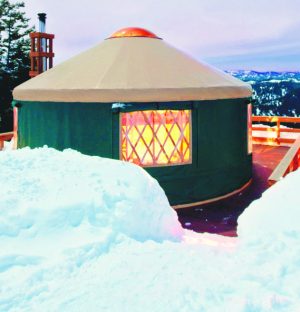August 08, 2019 (Cottage Grove, Oregon) – More than 40 years ago, Alan Bair, founder of Pacific Yurts, first saw the traditional Mongolian round-tent structure that would change his life. And he has never looked back.
![Alan Bair started Pacific Yurts back in 1978 with the idea of bringing people closer to nature. [P] Pacific Yurts](http://skitrax.com/wp-content/uploads/2019/08/Yurt-in-Snow-1-HI-RES.2-525x355.jpg)
So he did what most people probably wouldn’t do – he built his own. Before the days of social media, word of Bair’s bold new project started to spread the old-fashioned way – by a thing called a newspaper.
“I lived in this yurt while working on Oregon reforestation projects in the mid-’70s. When a local news article featured the yurt, calls and letters began to trickle in from people asking for help building their own,” Bair explained. “Suddenly, I found myself in a niche market for simple, affordable structures.”
Yurts are incredible versatile structures, which can be very simple or as luxurious as the imagination allows. They are light, fairly easy to construct and require minimal impact on the environment as there is no cement foundation or anything that can’t be taken up and removed when required.In 1978, Pacific Yurts was launched, with a customer base almost exclusively in the Bair’s home state of Oregon. The first product was a simple, rustic yurt that was easy to construct, had handmade skylights and was fashioned out of marine canvas. But the company focused on product innovation, and it wasn’t long before more modern yurts took over.
“Since our inception, we have focused solely on the design and production of modern yurts, so our first product was essentially a simple, rustic version of what we produce today,” said Bair. “Over the past four decades, we have upgraded and refined the materials and construction methods that are used, as well as developed new features/options that can be added to the product.”
For instance, in 1988 Pacific Yurts started making good use of a reflective insulation developed by NASA. Turns out, NASA has some pretty smart people there, and the material made the structures much warmer and more versatile for use in different climates. A year later, snow and wind kits were added, as well as central-column upgrades that added professionally engineered snow- and wind-load ratings to current structural codes. Other advancements included window awning frames, tropical cupolas and efficient Low-E thermal-glass windows.As a result, yurts can be found in a wide range of locales. For instance, there is a Pacific Yurts structure at the American embassy in Mongolia. And in Texas, one customer placed a yurt 35 feet up wrapped around a huge cypress tree.
“The entire yurt and exterior deck are completely supported by the tree, and the only way to get to it is a suspension bridge spanning from the nearby hillside, where a bathhouse has been built,” Bair said. “The customer utilizes the yurt as a very unique ‘treehouse’ accommodation. We had to design a couple of custom features for this interesting installation, but it is beautiful and provides them with steady rental income.”
Another boon to business and the growth of yurts in general happened when the company had a yurt on display at the Oregon State Fair. In the summer of 1993, one person was particularly interested in the novel structure and its potential for backcountry-camping accommodation. He happened to work for a state’s parks department that was in the throes of a financial crisis and on the lookout for new revenue streams.“One thing led to another, and Oregon State Parks Department ended up installing two small yurts at a coastal location as a pilot program. Based on the popularity of those yurts and tremendous word of mouth, additional yurts were added to the system,” Bair explained. “Oregon State Parks currently has close to 200 Pacific Yurts in its system, and many other state park systems have followed suit by added Pacific Yurts of their own.” Now yurts of all shapes and sizes can be found in campgrounds across North America.
When asked for a few favourite yurt-forward getaway spots in the U.S., Bair suggested Treebones Resort in Big Sur, Calif. with 17 comfortable yurt rentals overlooking the beautiful Pacific Ocean, as well as Stay Nantahala in Topton, N.C., which has four 30-foot-diameter luxury yurts. He also cites Savage River Lodge in Frostburg, Md., where there are eight 30-foot yurts installed along a wooded hillside, each equipped with radiant floor heating in addition to a gas fireplace, cozy furniture and luxurious bathroom. Every yurt has a private deck to enjoy the relaxing views.
Bair started the company with the idea of bringing people closer to nature, so it is no surprise the environmental stewardship is a big part of the Pacific Yurts philosophy. As Bair explained, yurts are quite environmentally friendly in terms of resource efficiency. But there are many other ways the company strives to meet its environmental targets, according to Bair.
“Utilizing lumber harvested from carefully managed sustainable forests and choosing the appropriate grade and length of each component minimizes waste in our production,” he explained. “We also recycle sawdust and small wood trim to local gardeners and crafters, and a large portion of the electricity used in our manufacturing facilities comes from renewable wind power.”
![People are naturally drawn to the beauty, simplicity and versatility of yurts. [P] Pacific Yurts[P] Pacific Yurts](http://skitrax.com/wp-content/uploads/2019/08/IdahoStateParksYurt.2-525x350.jpg)
The versatility and beauty of the yurt is something that allows for its continued growth in the future.
“Many people are drawn to yurts because they can provide the strength and security of a site-built cabin, while also retaining a close connection with nature [similar to what] you’d experience in a tent,” says Bair. “You can hear wind blowing through overhead trees or other soothing sounds of nature, but remain comfortable in an insulated structure with modern conveniences.”
Just the facts
Pacific Yurts, Inc.
77456 Hwy 99 South
Cottage Grove, OR 97424
541.942.9435 x103
www.yurts.com






![National camp action [P]...](https://skitrax.com/wp-content/uploads/2019/08/Duluth-4-2019-08-08-at-10.46.51-AM-300x246.png)
![Matt Liebsch on the CXC Elite Team [P] CXC...](https://skitrax.com/wp-content/uploads/2019/08/Matt-Liebsch-CXC.2-525x700.4-300x267.jpg)
![Dan LaBlanc [P]...](https://skitrax.com/wp-content/uploads/2019/08/Dan-LaBlanc-img_1855.3.jpg)

![Yurts can be rustic or luxurious. [P] Pacific Yurts](http://skitrax.com/wp-content/uploads/2019/08/PY-30-Interior2019.2-507x760.jpg)
![Strength, security, comfort and close to nature.[P] Pacific Yurts](http://skitrax.com/wp-content/uploads/2019/08/Stone-Mtn.2-525x389.jpg)
![Yurts are quite environmentally friendly in terms of resource efficiency. [P] Pacific Yurts](http://skitrax.com/wp-content/uploads/2019/08/Glowing-Yurt.2-525x729.jpg)
![Yurts can be found in campgrounds across North America. [P] Pacific Yurts](http://skitrax.com/wp-content/uploads/2019/08/Stream-View-2.2-525x348.jpg)